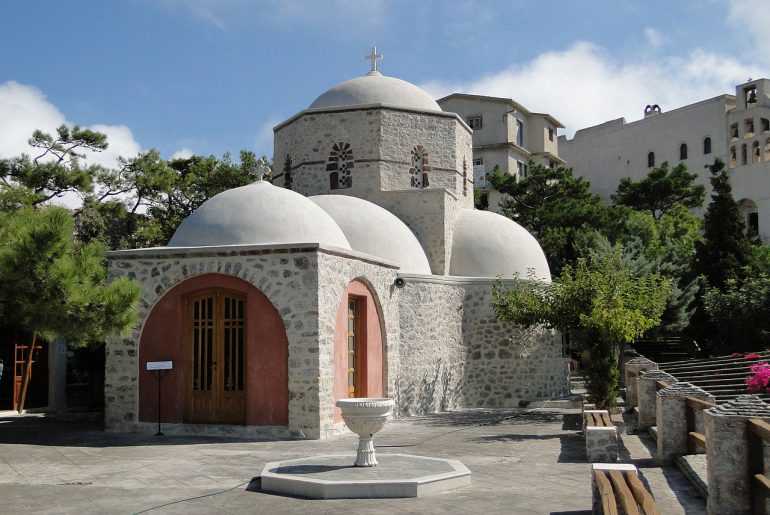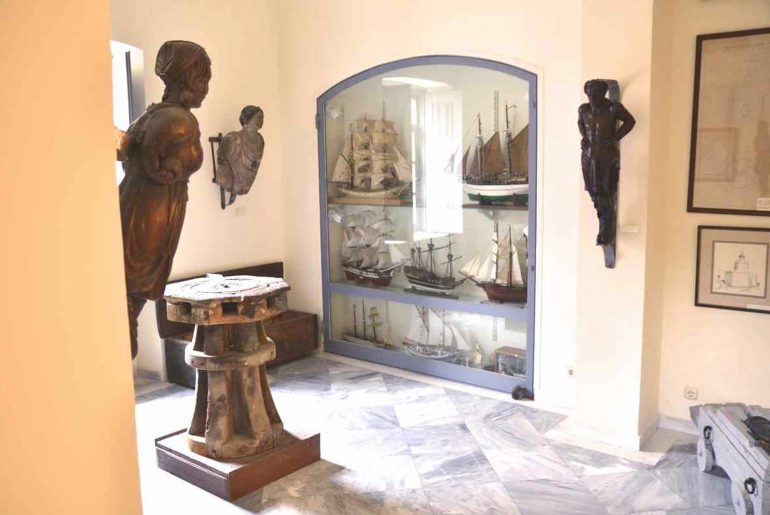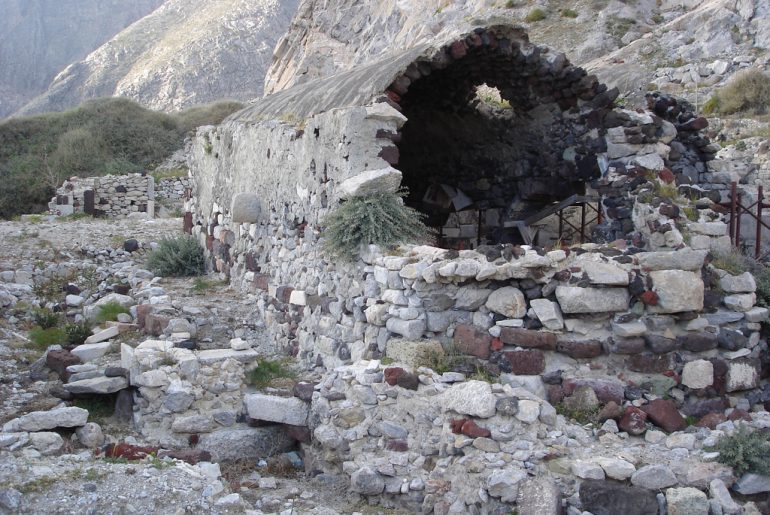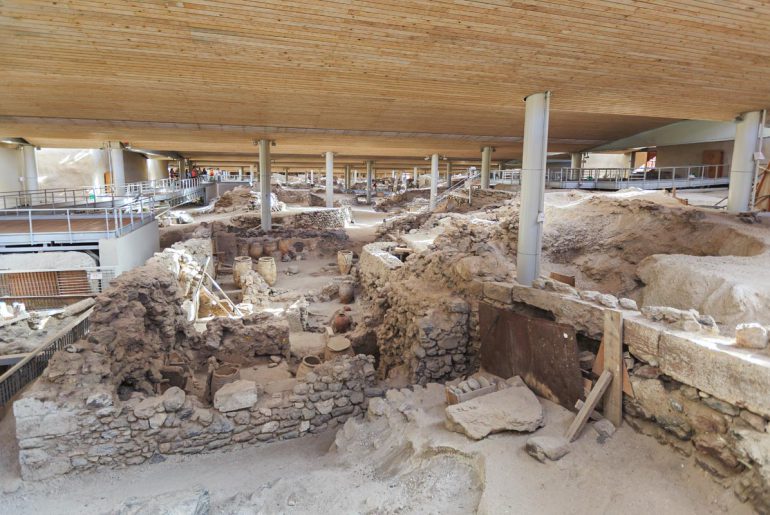Santorini is the iconic Greek destination with the most fascinating sunsets and postcard-pretty cliff houses carved on the slopes of the caldera, coated in sparkling white, which contrast with the light cobalt blue of the church domes and with the vivid magenta of the bougainvillea in bloom. It’s an island with a rich past, albeit checkered at times, a brilliant example of human endurance in challenging conditions. So, we’ve rounded up eight of the must-see museums in Santorini that show some of the historical trials that make the island great.
Monastery of Profitis Ilias, a Must-see in Santorini
The Monastery of Profitis Ilias stands on the highest peak of the island at an altitude of 567 meters above the sea level. It is located three kilometers away from the village Pyrgos in Kalliste, in the southeastern part of Santorini. You’ll reach it within 40 minutes when you drive from Santo Maris Oia Luxury Suites & Spa.
Lignos Folklore Museum: Must-see in Kontochori
The Lignos Folklore Museum is located in Kontochori, just a short 30-minute drive from Santo Maris Oia Luxury Suites & Spa. It occupies a traditional cave house that dates from 1861. The house survived the earthquake of 1956 and was restored in 1976.
Must-see in Santorini: Tomato Industrial Museum
The Tomato Industrial Museum is a fascinating attraction at the Santorini Arts Factory, which is a multi-purpose gallery and cultural space in Vlichada. It is a recent addition to the cultural stage of the island, as it opened its doors in 2014.
Must-see in Oia: Naval Museum of Thera
The Naval Museum of Thira in Oia opens at the beginning of April every year and welcomes visitors until the last day of October. Located in an old mansion, especially restored to fit its new purpose, the museum documents the maritime history of the island from ancient times to the XIX Century.
Must-see in Santorini: Museum of Minerals & Fossils in Perissa
The Museum of Minerals & Fossils is one of the main museums of Santorini, albeit not as known as the Museum of Prehistoric Thira in Firá. The museum is managed by the Cultural Society of Thira, and is located in Perissa.
Must-see in Santorini: Museum of Prehistoric Thira
The Museum of Prehistoric Thira is a Santorini attraction you shouldn’t miss. It is less than half hour drive from Santo Maris Oia Luxury Suites & Spa, in the capital of the island, Fira.
Ancient Akrotiri Is one of Santorini’s Must-see Sites
The ancient Akrotiri is a Minoan Bronze Age settlement in a village in the southwestern part of the island, less than an hour drive from Oia, and only 15 km drive from Fira, the capital of Santorini.
A Santorini Guide for First-Time Visitors
Santorini is one of the world’s iconic destinations, a stunning postcard recognized by anyone who ever dreamt of travel. From her multicolored cliffs that rise ominously from the aquamarine depths of the Aegean to the whitewashed buildings huddled on the rim of the cliffs, this is a place of and for daydreams. Dazzling panoramas, legendary sunsets, and unbelievable volcanic-sand beaches lay waiting to dazzle visitors young and old.
Of all the places people put on their “bucket lists,” Santorini leaves upwards of 1.5 million tourists a year stunned by her sheer beauty and allure. This most volatile and enigmatic Cyclades isle is officially called Thera, after the son of Euphemus, who was one of Jason’s Argonauts. Out of the myths of prehistory, garnished by tales from Plato of Atlantis and other epic legends, Santorini does not have any “little history.” Here you’ll find the stuff dreams are made of growing out of the black sands of time.
As legend has it, Thera was a major naval base of the Minoan Empire utterly destroyed when the volcano erupted about 1450 BC. The violent explosion of magma beneath this mystic island emptied the gigantic basin below the island, and caused the collapse of the volcano. The billions of cubic meters of seawater emptied into this blazing abyss unleashed what some believe, was the largest explosion in human history, a blast that delivered 60 meter-high tsunami waves to nearby Crete and Egypt further beyond. What remains of the island many believe was fabled Atlantis, is a caldera (or crater) with towering cliffs along the east side, which is now Santorini’s trademark landscape dotted with settlements along its edge.
First-time visitors to the island will at first be amazed by the dizzying heights and views of the caldera that provoke many to gasp in awe. From the busy capital of Fira, visitors find the 15-minute walk to nearby Firostefani an uplifting experience, and then a further quarter hour’s trek leads to the highest point of Santorini, where Imerovigli village offers unimaginable photo-taking opportunities. It is these three settlements that get most of the attention, along with the iconic Oia – the most photographed village of Thera – to the north.
Farther east, volcanic sand beaches beckon sunbathers, snorkelers, and swimmers where the land levels out onto the sea. The resorts of Kamari and Perissa offer a more traditional appeal, along with water sports, bars, and beautiful promenades. Then there’s Santorini’s spectacular vineyard-lined inland, where travelers can catch a glimpse into the past of the island. At Pyrgos and other villages, the cuisine of Santorini takes on a new life, and the charm of ancient Greece comes to life. Wine tastings at more than a dozen local wineries compliment any hike into the island’s inner sanctum, and any number of wine or archeological tours come highly recommended. A few of Santorini’s highlights for first-time visitors include:
- See the impressive Museum of Prehistoric Thera in Fira, which reveals the puzzle pieces of the island’s distant past via the archeology of legendary Akrotiri.
- Sunsets: Prime sunset-seeing is accomplished best in Oia, where tens of thousands come to admire the sundown on the island.
- Hike from Fira to Oia: While the walk is challenging under the scorching sun, this is one of those experiences you take home and tell about forever.
- Swim in the hot springs: Take a boat tour to the base of the caldera and dive into the hot springs in the midst of the sea – this is a fantastic experience.
- Swimming, as suggested, can best be enjoyed at the black sand beaches in the east.
- Tours: Any number of companies lead guided archeological, wine and culinary, and sunset photography tours.
- Akrotiri: The fascinating site of Akrotiri displaying a Minoan city destroyed by the volcanic eruption during the Bronze Age is a must-see.
No matter what else you do while on Santorini, be sure and book at least one tour. They’re simply fun, informative, and the best way to get to know more about the island. Whether you pick a spellbinding helicopter flight over the caldera, or a luxury wine tour, there’s no better way to pack a wealth of information and fun into a first-time visit. For the visitor who likes venturing off-the-beaten-path, the boat trip to uninhabited Thirassia on the western side is a memorable adventure. Oh, and be sure to take a walk to Skaros Rock for an unbelievable view. Finally, no Santorini suggestion guide could be complete without recommending a swim in Ammoudi Bay and a dive off the cliff at Agios Nikolaos.
The best times to visit Santorini are spring and fall – from April to May and September to October. Temperatures during these months are not as elevated as they are from June to the end of August. Offseason, in the winter months – from November until March – most of the hotels, restaurants, and shops, are closed, but the experience is unique and ideally suited for those who are looking to experience the island like a local.
First-time visitors to Santorini may also want to consult this list of frequently asked questions before traveling.
Santorini: A Prehistoric Land
Seven thousand years ago the Santorini as travelers know it today was a vastly different human habitat. What must have begun as a collection of Stone Age fishing and farming villages, soon became a trading center between Minoan Crete and Cyprus sometime after 3000 BC.
Scholars think that ancient Santorini became significant because of its strategic location first, and later because of critical trading with goods like copper. For these and other reasons, Santorini and its most famous ancient settlement of Akrotiri must have been a shining example of culture and civilization. Today visitors can still see remnants of paved streets, a cutting edge (for the time) drainage system, multistoried buildings, and artifacts of indescribable beauty and innovation. As part of the Minoan Civilization, Akrotiri and ancient Santorini flourished for more than 500 years, until the catastrophic eruption of Thera sometime between 1642–1540 BC.
Archaeologists estimate the first settlements on the island date back to the Post Neolithic Period. Akrotiri today is a kind of time capsule, not so different from the Roman city of Pompei, where the volcanic matter that covered the city and the whole island ended up protecting and preserving the buildings. Some historians contend that Santorini was the inspiration for Plato’s story of Atlantis, as mentioned in his dialogues Timaeus and Critias.
When visiting the island, travelers should be aware there are actually two settlement sites from ancient antiquity. Akrotiri is the oldest known settlement, but Ancient Thera (Αρχαία Θήρα) on top of Messavouno dates to the time of the Spartan settlers who came to the island during the 8th century BC. It is from this high dwelling place that Santorini tourists will capture the most stunning views anywhere on the island.
We also recommend visiting Fira, where you will find several museums that are worth seeing. First, the Prehistoric Museum holds many exhibits from Akrotiri and other archaeological sites on Santorini. There’s also the Archaeological Museum, that presents findings and artifacts from Ancient Thera. Also, a must-see is the Gyzi Megaron and the Museum of Local History, situated in the Kontochori Quarter.
Finally, there is indeed something magical about Santorini, and something more than the visual of a vanishing sun in the West. Certainly, the dramatic landscape of jagged hills plunging into the blue Aegean is stunning, and the picturesque whitewashed houses with blue roofs create a living postcard for visitors. Great people and remarkable cuisine make the island special too. However, one cannot help but sense there is something more here. Something magnetic that compelled those adventurous settlers to make the journey into what would become the new world.
Maybe an ancient Greek myth serves to explain the island’s distinctive character. According to old Greek stories, Santorini was formed out of a miracle connected to the famous Argonaut expedition. According to the legend, Jason and his shipmates were on their way home, when they landed on Anaphe, a small island of the Aegean Sea.
It was here that Euphemus had a vision of making love to a nymph, a siren who was the daughter of the messenger of sea god Triton. After their union, the woman told him she had become pregnant with his child and chided him over how her father would be angered. She begged for a place to hide so that she might escape the wrath of the god, to which Euphemus responded by throwing a clod of dirt into the sea. This speck miraculously re-emerged from the vacant sea and turned into an island. Euphemus named it Calliste, which means the most beautiful, but the name “Thera” is from his son of the same name, who was born there. And so, it seems clear that Santorini has been beloved by the gods from the dawn of times.









